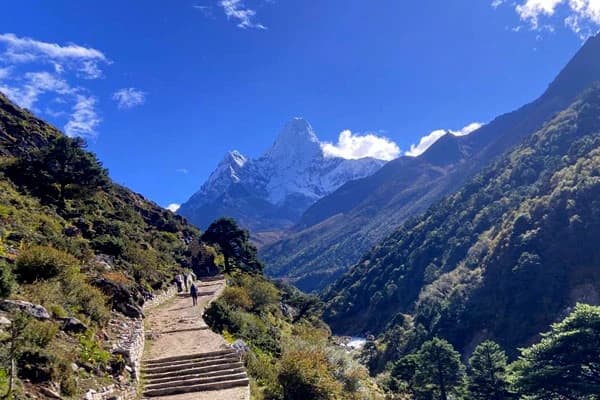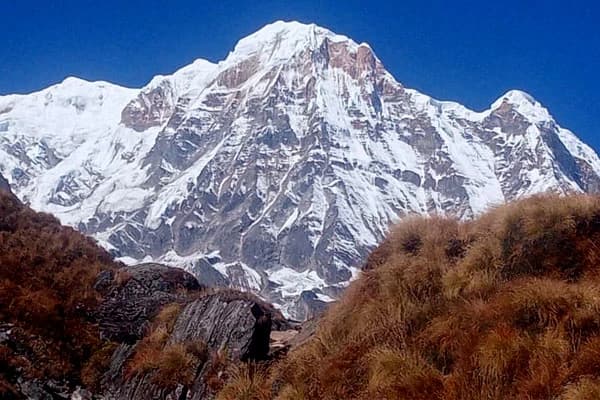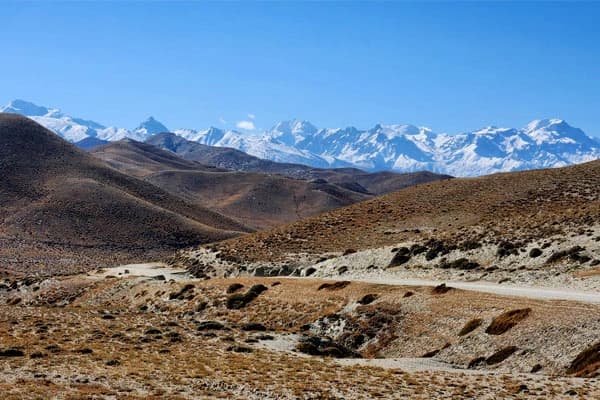Why Choose the Everest Base Camp Trek for Indian Passport Holders?
The trek to Everest Base Camp for indians has several advantages, compared to other foreign trekkers, highly contributing to the massive growth of Indian visitors within the Everest region. Being close to India, Nepalese, and indians is deeply intertwined with and familiar with the languages, cultures, likes, and dislikes, which makes the trip go smoothly, for indians, without any problematic situations, and unshockable, Himalayan lifestyle. Just like that, other various aspects such as trek cost, accessibility, simplicity to manage logistics, no language and cultural barriers, along with many other reasons, make the Everest Base Camp Trek for indian citizens, a hassle-free adventure.
Affordability
Comparatively, the trip to EBC from India is more on the budget-friendly side, considering the fact that the cost of air travel, or the roadway, is affordable, depending on the season. At the same time, the Nepal entry visa fee and the permit cost reduction for SAARC natives, along with the no visa fee requirements, give a firsthand accountability on saving your money. Apart from that, the exchange rate is higher for INR (Indian currency) as INR 1 is equal to NPR 160 (Nepalese currency).
Easy Accessibility
Along with no visa requirement, to reach Nepal, there are many transportation means that you can opt for, for instance, railway, public buses, or even by airplane; the cost is cheaper, as it shares a border with Nepal, you can take full advantage of saving extra time and budget.
No Language Barrier
One of the major advantages of being an indian citizen that you will ever get while trekking to the Himalayas is that even though you are not familiar with Nepalese or English languages, you can speak your own native indian language, and interact with locals easily. Nepali people can speak, indian language easily, due to the popularity of indian movies and songs, which helps you to communicate with guides, porters, and other fellow hikers, as well, without any misguided communication, making the trip safer, enjoyable, and homely.
Untamed Nature and Panoramic Mountain Views
This trip takes you on a complete roller coaster ride within the iconic Everest region, from the beginning to the very end, showing you the great views from popular viewpoints, Himalayan flora, wild species, and the marvelous transformation of the landscapes from forest woodland, Sherpa villages, to the heavenly glaciers and mountains. Throughout the journey, get ready to be accompanied by the almighty peaks such as Lhotse, Ama Dablam, Tharmseku, Makalu, and many others. Meanwhile, attaining the highest point - Kala Patthar, the panoramic view of Mount Everest along with the Khumbu glacier will surely leave you spellbound.
Sharing Culture and Spirituality Connection
While many foreign tourists are unfamiliar with our culture and daily lives, the cultural ties of hinduism and buddhism religions, become a blessing to indians, where you can feel the spirituality while visiting monasteries connected with deities, in the Khumbu region, along with mythological history connected with nature and mountains, which lets you immerse in the architectures, meditations, and lifestyles of the locals, rather than just gazing at the mountains, wh enriching your journey even more.
What are the documents required to trek to Everest Base Camp for Indian Citizens?
To arrive in Nepal, for the Everest Base Camp Trek from India, there is no necessity to arrange a visa or pay the Nepal entry fee; however, to prove your identity as an indian citizen, a valid indian passport, or any government-issued ID card, such as an Aadhar Card or Voter ID, is required. There are no limitations for indian to stay here in Nepal, whereas to enter Nepal, via an Indian vehicle, requires a customs permit with nominal fees, so if you are travelling with a private vehicle, to reach Kathmandu - the capital city, then make sure to acquire one.
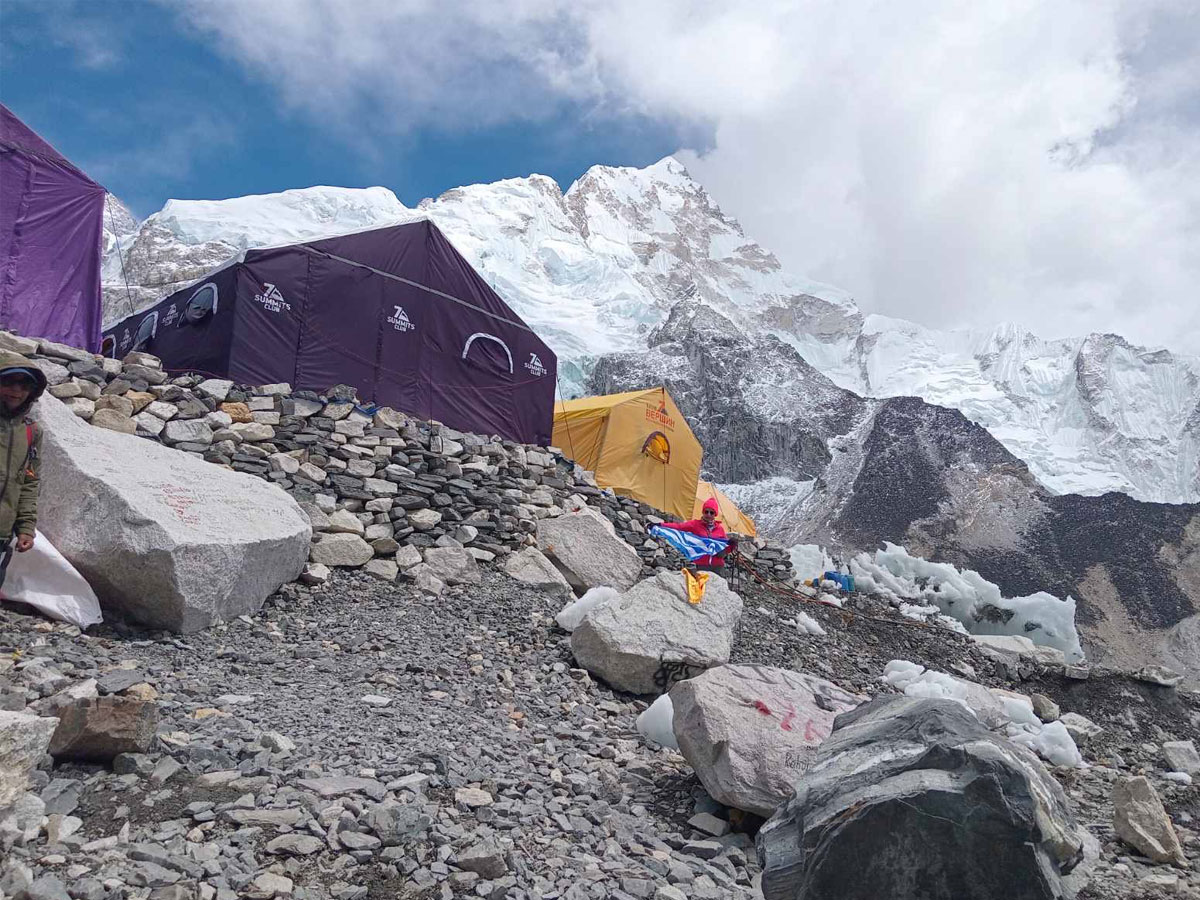
Here are the other travel documents required for the Everest Base Camp Trek for Indian citizens, that must be attained to hike legally, along the restricted and protected trailhead:
Travel Document Considerations
- Valid Indian Passport or Government-issued ID Card such as Aadhar Card, or Voter Card
- 3-4 passport-sized photos to attain permits
- Both children and senior citizens also require identification validation, such as a passport or government-issued ID for seniors, and a birth certificate or school ID, just for an identity check for kids below 18 years old
- Permits must be attained for all age groups; however, the permit fees, below 10 years old kids, traveling with parents are on the lower side, or redeemed as well, but permits must be acquired to hike legally
Permits Requirements
The Everest Base Camp Trek permits for Indians remain the same, just like other nationalities' hikers, which are two major permits, firstly the Sagarmatha National Park Entry Permit, and secondly, the Khumbu Rural Municipality Permit; however, the price is relatively lower for SAATC nationals, including Indian citizens, than foreigners from other nationalities.
- Khumbu Rural Municipality Permit: The cost is approximately NPR 2000 (INR 1250) for the first 4 weeks (1 month), within the Everest region, whereas, if the length of the hike is extended more than a month, then an additional cost of NPR 2500 (INR 1564) is required per head.
- Sagarmatha National Park Entry Permit: This permit can be attained either in Kathmandu at the Nepal Tourism Board Office or at Monjo - the entry gate, the cost is approximately. NPR 1500 (INR 937), per head.
Travel Insurance
While the travel insurance isn't compulsory to attain, specifically, for indian trekkers, and remains optional, however, it is highly suggested to grab a good travel insurance policy, for safety purposes, and immediate access to the health lines, if any unfortunate situations occur. Please, take note that the trek to EBC is a high elevation mountain journey, where the risk is circulating, whether it's altitude sickness, minor injuries, or other problems like thefts, trip or flight cancellation, the insurance will become your rescue, on a budget. We highly recommend, you obtain a policy that includes the helicopter evacuation over 3000 meters, and medical expenses, along with other health-related factors, for a secure trip. Having travel insurance assures that your trek becomes a hassle-free, comfortable adventure, with security and peace of mind, and saves thousands of overcharging medical expenses.
Best Time to Visit Everest Base Camp from India
The best seasons for the Everest Base Camp Trek for Indian citizens stand out to be Spring and Autumn, as during these peak seasons, no matter whether you opt for land or air transportation to reach the EBC or Nepal, from India, the trip is sure to be safe and sound, due to dry routes. During this peak time, the weather remains stable and the temperature becomes moderate, with no high humidity, ensuring clear views of the mountains and landscapes in each stride and easy ascent, without draining physically and mentally. From the very beginning of March till the very end, the lush green valley turns into paradise, with blooming red rhododendrons and pines, with long hours of offering long sunlight hours to explore the Himalayas.
On the other hand, during the autumn seasons, the greenery surrounding turns into golden hour landscapes, with the crops blooming beautifully, whereas the main festivals, Dashain and Tihar, also fall between September to November, offering a distinct insight into the Himalayas. As the season comes after the end of the monsoon, you can expect clear mountain views and landscapes. Meanwhile, if you are willing to head for Everest Base Camp during winter times, then the drop in temperature and the continuous snowfall near the base camp make it a challenging journey; however, the snow-covered Himalayan peaks make your journey ongoing and persistent with eye-catching views. Just ensure to be physically prepared and carry the gear accordingly.
Everest Base Camp Trek Itinerary for Indians 2025 and 2026
If you are an indian hiker, then this comprehensive outline of the standard trailhead is highly suggested, because it includes gradual ascents, with great acclimatization days, and covers every highlighted corner, without missing any corners, of the route, with great safe ascent, that matches all kinds of hikers.
Day 1: Arrival in Kathmandu, transfer to the hotel, and a pre-brief meeting in the evening with the guide and other teams
Day 2: Direct Flight to Lukla (2840 m) from Kathmandu for 30 to 45 minutes, and then start the trek to Phakding (2612 m)
Day 3: Ascend to Namche Bazaar (3440 m) from Phakding (officially entering Sagarmatha National Park)
Day 4: Rest or Acclimatization day in Namche Bazaar; Side Trip includes - Everest View Hotel and Khumjung village
Day 5: Namche Bazaar to Tengboche Monastery at 3880 meters
Day 6: Hike to Dingboche
Day 7: Rest or Acclimatization day in Dingboche; Side Trip includes Nangkartshang Peak (5100 m)
Day 8: Trek to Lobuche - 4968 m
Day 9: Trek to Gorak Shep from Lobuche for 3.5 hours, lunch break, and start the hike to Everest Base Camp (5364 m)
Day 10: Finally, reach the highest elevation, Kala Patthar viewpoint (5545 meters) at 4 AM for sunrise and then descend to Pangboche
Day 11: Descend to Namche Bazaar
Day 12: Trek to Lukla village near the airport
Day 13: Flying Back to Kathmandu with 30-45 minutes of flight and transfer to the hotel
Day 14: Final Departure Day, Back to Home country
What does the Standard Everest Base Camp route look like?
If you follow the standard trekking route of 14 days to Everest Base Camp, then it covers 5-6 hours of walking distance and 9 to 12 kilometers of distance coverage per day, with 2 acclimatization days included, which includes the arrival and departure day as well. The trek goes all the way through the iconic Sagarmatha National Park, right from the start till the end, which begins and concludes with a Lukla Flight.
Starting from Kathmandu, the journey begins with a Lukla Flight, for a straight 35 to 40 minutes, along with a trekking guide, which is an adventurous journey itself, showing the magnificent beauty of the massive transformation of the highlands from lush green forest and highly towering mountains. Soon after reaching Lukla Airport - Tenzing Hillary Airport, the trip is followed toward Phakding, along the soothing sound of woodlands, covered in rhododendron forest, and oaks, along the Dudh Koshi River.
The next day, the trek enters the legendary Sagarmatha National Park, after registering the permits, the pathway leads to Namche Bazaar, known as the bustling city, thriving market, or the capital city of the Khumbu region as well, as it serves many standard and luxury lodges, including the world's highest situated hotel - Everest View Hotel. The 4th day of this trek marks an acclimatization day here in Namche (3440 m), where the side trip directly ascends to the 5-star hotel, which shows the breathtaking panoramic mountain views of the Khumjung village, via monastery, Sherpa villages, and Hillary School, among the 2 option, you can choose either of these.
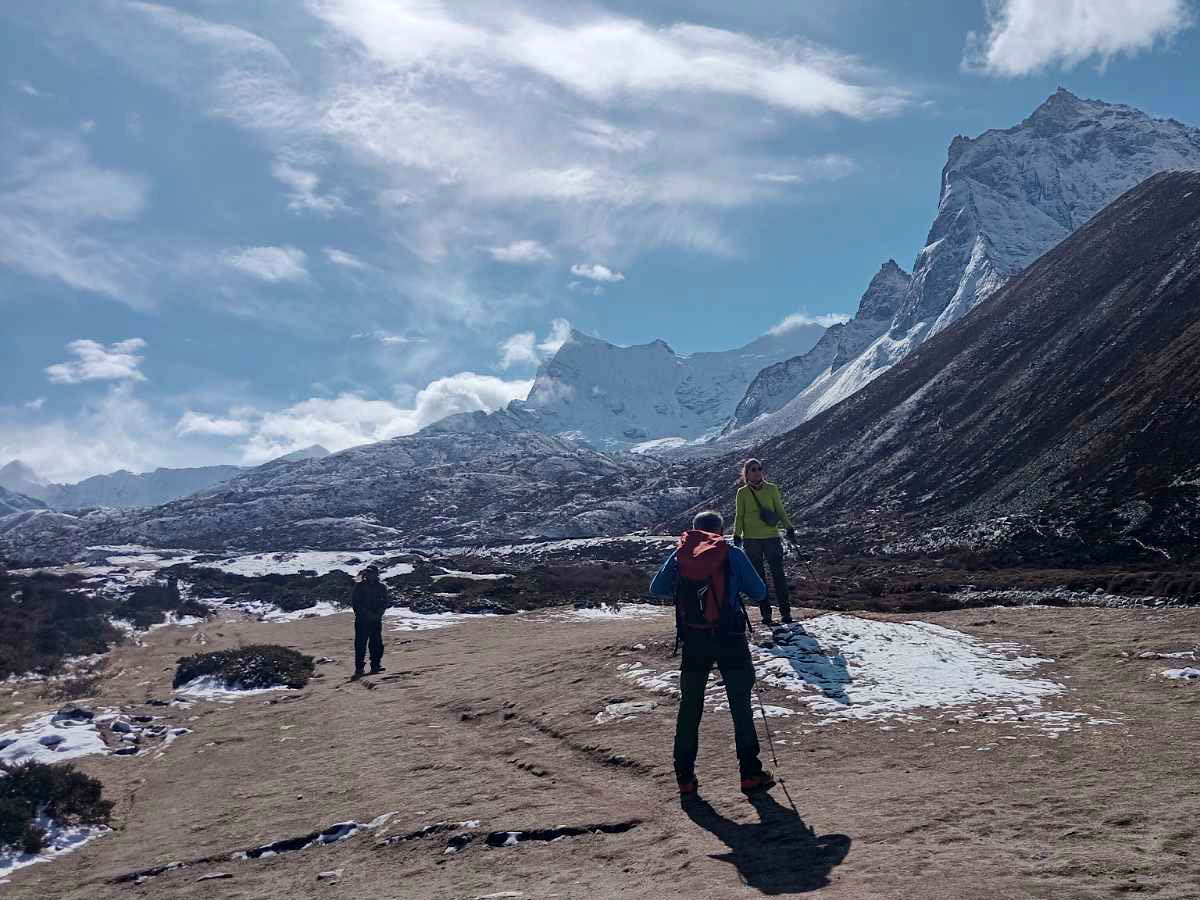
Continuing this adventure, the trip begins toward Tengboche monastery, perched at 3880 meters, on the 5th day, and ascends to the Dingboche village on the next day, which is our second acclimatization spot. During this excursion (acclimatization day) on the 7th day, we will reach Nangkartshang Peak at 5100 meters, which shows the best views of the Himalayan peaks, and acts as an intelligent act to adapt to the rising elevation, to proceed to the higher altitudes on the upcoming days.
The next day, the trip continues toward Lobuche, which leads to Gorak Shep on the very next day, where we will visit the Everest Base Camp (5364 meters), the launchpad of the world's tallest peak - Mount Everest, finally. Finally, on the 10th day, we will reach the highest point of this trek, the almighty Kala Patthar at 5545 meters.
This 14-day Himalayan adventure concludes, after flying back to Kathmandu from Lukla, followed by the trekking route via Pangboche, Namche Bazaar, and Lukla village for 3 days after returning from Kala Patthar.
How much does the Everest Base Camp Trek cost for Indian Citizens?
The Everest Base Camp Trek cost for Indian Trekkers is more on the affordable side than for other nationalities' hikers, costing approximately, with a price range from INR 65,500 (USD 780) to INR 99,850 (USD 1150) per head, for indians. The price highly depends on several factors, such as comfort, group size, along the kind of accommodations you are opting for, which covers all your requirements for the trip, such as Lukla flight cost, standard meals, accommodations, trekking guide, permits, and a porter, along with other additional benefits as well. If you are a bit budget-conscious, then you can minimize the cost and adjust the budget as per your estimated costing, without burning your pockets. However, to make the trip more affordable, you can trek in a group by joining our fixed departure for the Everest Base Camp Trek in 2025 and 2026, or directly opt for our Everest Base Camp Budget Trek.
Even though every necessity will be covered in the package, you might require additional expenses such as tipping the guide and porter, buying gear, and souvenirs, along with additional expenses within tea house, such as laundry services, electricity charging, wifi connectivity, hot shower, or any extra meals and beverages, except the standard meals - Breakfast, Lunch and Dinner with a cup of tea or coffee per day. To minimize personal spending, you can bring reusable water bottles and use the purification tablet, and also bring ready-to-eat snacks, such as protein bars, chocolates, like mini Snickers, or dry fruits, to quickly munch in the middle of the trekking route.
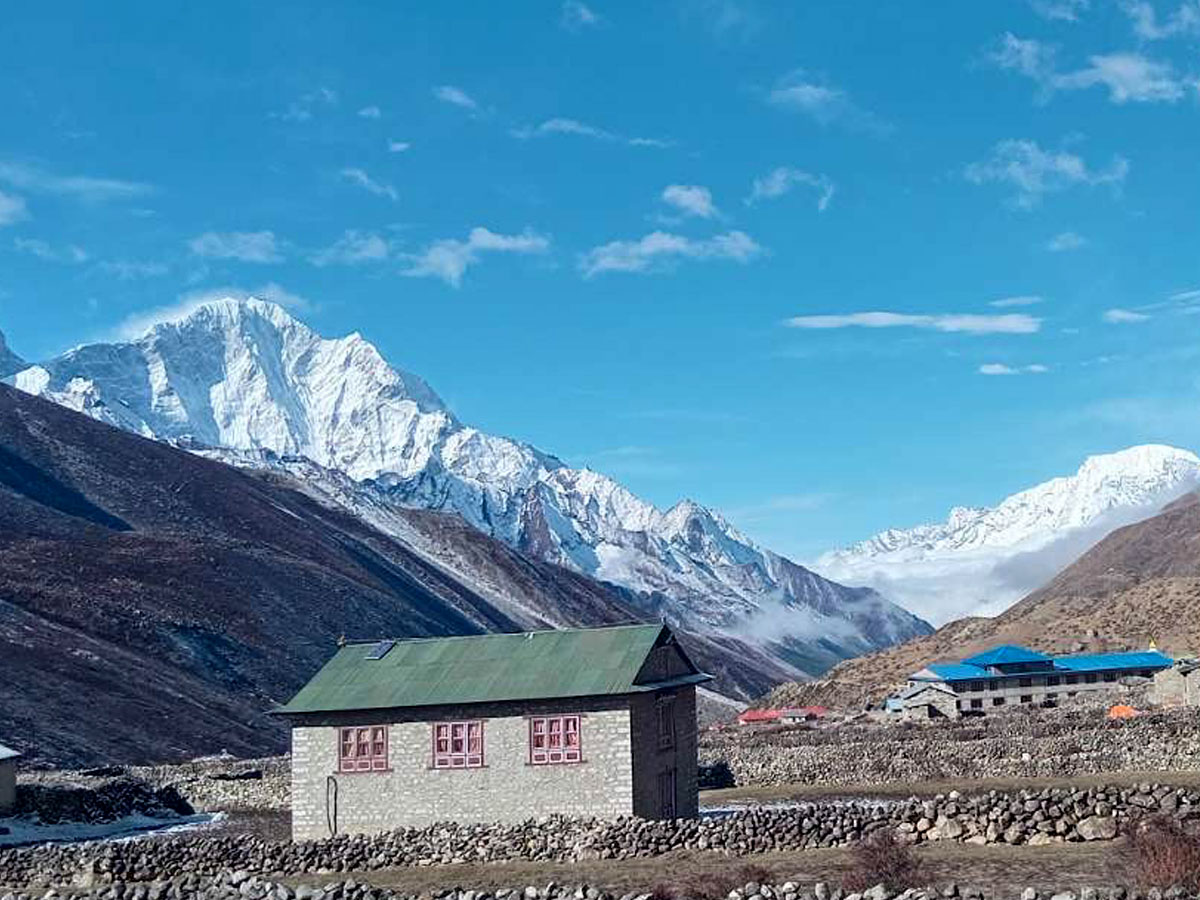
To save the overall cost, you can rent gear or essentials, hike in off-seasons, consider opting for group trips without fixed departures, and make pre-bookings by grabbing early bird offers before 2-3 months.
Here is a costing of the Everest Base Camp Trek for indian passport holders:
- Private Elusive Trip Cost (1 hiker): INR 99,850 for 1 indian trekker (USD 1160)
- 2 to 3 person Trip Cost: INR 79,000 for Indians (USD 895 per head)
- 4 to 6 person Trip Cost: INR 75,200 for Indian trekkers only (USD 850 per head)
- 7 to 10 person Trip Cost: INR 70,300 for Indian trekkers only (USD 785 per head)
- 11 to 20 person Trip Cost: INR 65,500 for Indian trekkers only (USD 734 per head)
Cost Inclusive and Exclusive for Indian Hikers: What’s Included and What’s Not?
Trip Inclusive
The following are the essentials covered while opting for our trekking package, where you do not have to bear extra cost, as the trip cost includes all the mentioned requirements:
- Free Airport Pick up and Drop off via Private vehicle (you will be picked up from the exit gate of the airport and get transported directly to the hotel)
- All the required permits: Sagarmatha National Permit and TIMS Card
- Experienced Licensed Local Trekking Guide, with English speaking fluency, including all his expenses
- 1 strong porter to carry your bagpack (maximum 22 kgs, which can be shared between 2 hikers), including all his expenses
- Standard meals: Breakfast, Lunch, and Dinner (3 meals per day with a cup of tea or coffee)
- 4-star accommodation for 2 nights, in Kathmandu on a BB Basis (Buffet Breakfast)
- Lodges / Tea house throughout the trek
- Assistant Experienced Licensed Guide, for more than 6 trekkers
- Lukla Flight Cost: from Kathmandu to Lukla and Lukla to Kathmandu
- Seasonal Fruits throughout the trip
- Complimentary benefits provided only by Destination Himalaya Treks, such as a T-shirt, a Cap, and a Duffle Bag with a Sleeping Bag on request
- An oximeter to check your pulse rate and a water purification tablet
- Basic First Aid Kit
- Trip Completion Certification after the trip is completed in Kathmandu
- Farewell Dinner here in Kathmandu with a cultural program
- Emergency Rescue Management (covered by your travel insurance)
- Required Local Taxes, VAT, and other expenses
Trip Exclusive
- International Flight Ticket
- Personal Trekking Gears and Equipment
- Travel Insurance (must grab a good policy that includes helicopter evacuation)
- Personal spending such as laundry services, wifi, charging, alcohol drinks, hot shower, or hot extra water
- Tipping for guides and porters (10 % of the total trip cost is expected)
Mentioned Exclusive points are the cost insights, that is not included in our trip cost/package, where the expenses trip's exclusive cost must be bear by your own.
How to reach Everest Base Camp from India?
To do the Everest Base Camp Trek from India, the first and foremost thing that you must consider is reaching Nepal - Kathmandu (the capital city), through many means of transportation, and then proceeding further journey from Kathmandu with a Lukla Flight, and then the trek continues with a walking trekking trail, followed by Phakding, and finally attains EBC and the highest point - Kala Patthar.
To reach Nepal from India
Being in proximity to Kathmandu, sharing a border with India, you can travel to Kathmandu either by air or by land. Many cities in India serve as an international Flight hub, in major areas like Delhi, Mumbai, Kolkata, and many others, which you can check on Google, which will take you directly to Kathmandu, Nepal - Tribhuvan International Airport. For a more budget-friendly option, opt for land transportation, through local bus, or private vehicle, through main points such as Uttar Pradesh (UP), Bihar, and West Bengal, which takes approximately 8 to 9 hours, from - India Border.
To reach Lukla from Kathmandu: Regular Flight
The standard way to reach Lukla, is the direct regular flight to Lukla, for approximately 35 minutes, which is cost friendly, compared to other rides, via air, then, after reaching Lukla Airport, the trek is followed by Phakding, and other iconic points, for 8 to 9 days, depending on the trekking route and itinerary with 2 acclimatization days. However, just take note to set a buffer day for 1-2 days, as the flight usually gets delayed during the peak trekking season, and also, it might get canceled for a day, due to unfortunate weather conditions and traffic congestion.
At the same time, during busy seasons, the Lukla Flight might get diverted into Manthali-Ramechaap Airport, which is approximately. 128 kms away from Kathmandu, requiring 7-8 hours of bus/jeep drive, where you must take a flight to Lukla, from Manthali.
Comfort and Luxury Option: Helicopter Ride
To avoid the hassle of the Lukla Flight, you can directly take a flight to Lukla, with a helicopter ride, on a sharing basis with 5 other passengers, or if time doesn't fit and you got only 1 day left, then, the best option stands out to be 1-day Helicopter Tour to EBC, that directly takes you to the lap of the world's highest peak.
To enjoy the aerial view and thrill of trekking experience, you can opt for Everest Base Camp with Heli Return, which follows the standard trekking route to EBC, however, returns to either Lukla or Kathmandu via helicopter ride, avoiding the trek back to Lukla, with an extra cost.
Land Option to reach EBC
If you are thinking about avoiding the Lukla flight, then you can take a roadway option to reach Everest Base Camp, by opting for a jeep ride from Kathmandu to Jiri or Salleri, by following the ancient trailhead, classical route. Opt for the EBC Trek via Jiri, which takes almost 19 days, to complete this Himalayan adventure, exploring the lower Khumbu region and ancient Sherpa villages.
Is it possible and safe to do the Everest Base Camp Trek solo for Indian Citizens?
Yes, solo trekking to Everest Base Camp for Indian trekkers is possible, and can surely be commenced alone safely; however, there are several considerations that you must look forward to before venturing out to EBC. Even though, solo trip is possible, one must hire a licensed, experienced trekking guide, since the new rule was bypassed in April 2023, for safe navigation and immediate medical assistance when required, if any unfortunate situations occur in the highland.
Trekking with a guide, without any group or partners, allows solo indian trekkers to feel the serenity of the Himalayas, without any disturbance and walk at their own pace, without worrying about matching other trekking levels. Unlike other restricted trekking routes, the trailhead within the Everest region is well facilitated, with many tea houses and Sherpa villages, which makes the trip secure and safe to traverse through. At the same time, as both Nepalese and indian hikers share similar languages, cultures, likes, dislikes, lifestyles, and spiritual beliefs, you won't find any hassle in interacting with locals, or even guides, making the solo trek surely easy and safe.
However, a solo trek to EBC does demand physical and mental preparations beforehand, and one must acquire the trekking permits as required, and also, travel insurance, and an itinerary, with a gradual pace with well-set acclimatization days, for a safe and sound trek to Everest Base Camp for Indian citizens.
Foods and Accommodation Availability
As the route to EBC is well facilitated with all the required amenities and luxury facilities as well, food and accommodations on the Everest Base Camp Trek for Indian Passport holders offer a wide variety of meal options and comfortable tea house settings. As sharing the same taste palette, as Nepalese, which is spicy and filled with herbal spices, indian trekkers will find the meal options that match their taste palette, with vegetarian, vegan, and non-vegetarian options available.
While the morning menu includes several breakfast options, such as Tibetan bread served with chana and egg, toasted bread with any kind of eggs (poached, boiled, fried) along with jam and butter, oat meals, and granola, for healthy western options. On the other hand, varied indian options such as Aloo Paratha, Gobi Paratha, Chapati with any kind of veg soup curry, etc, with masala tea are available. For the lunch and dinner options, such as dumplings, thukpa, noodles, sandwiches, and ultimate Nepalese dal bhat with side dishes, such as lentil soup, veg-non veg curry, spinach, any kind of pickles, which can be refilled, french fries, etc, are available. Some of the famous indian options are veg pulao, naan roti with curry, biryani (egg or chicken), fried rice, etc, are available.
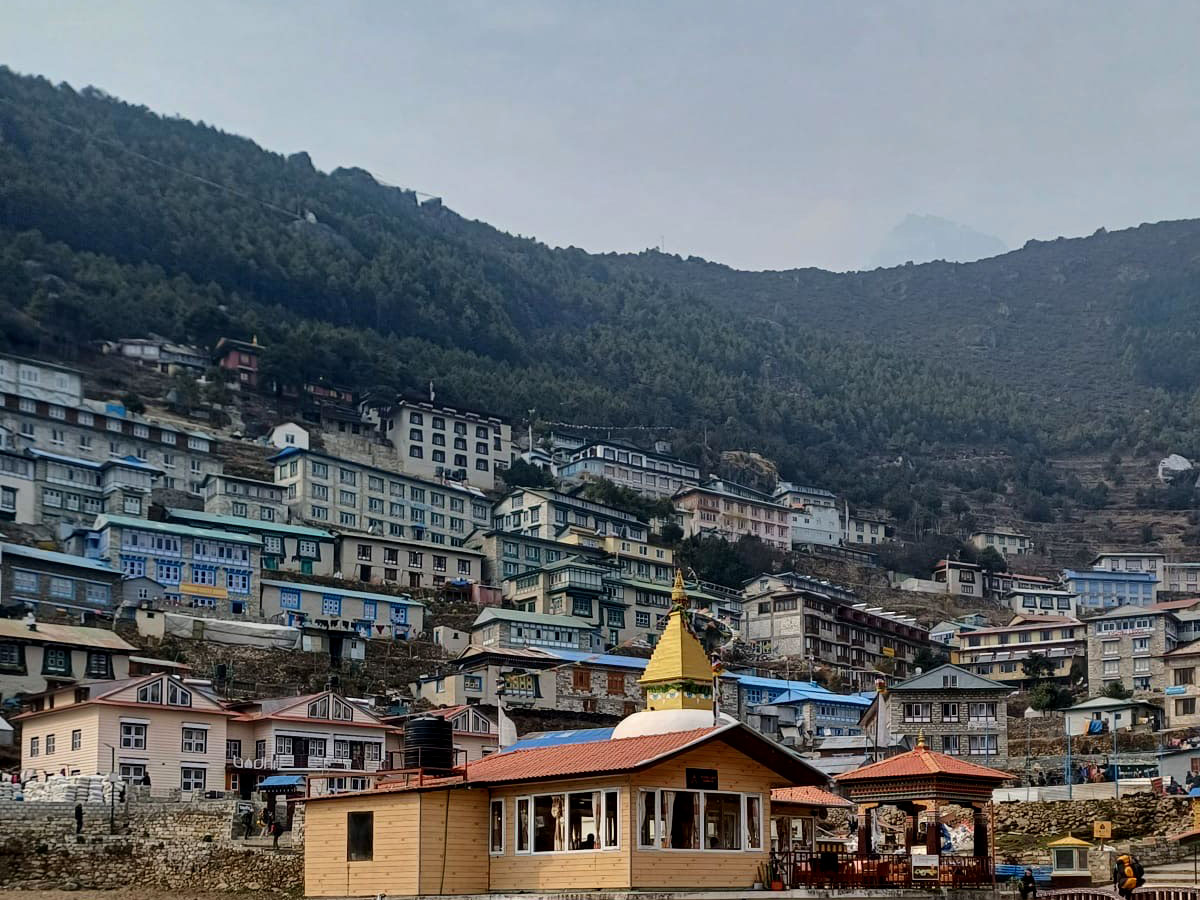
For the accommodation options, there are standard, budget-friendly, and luxury lodges available, with all the amenities such as laundry service, wifi, charging, etc. are available, with twin and double bedding configurations. While at the lower and mid elevations, at notable places such as Phakding, Namche Bazaar, Tengboche, to Dingboche, rooms with attached washrooms on a western basis are available. Meanwhile, after crossing the elevation of over 4000 meters, at the basic tea house, only an eastern-style bathroom is available.
Packing List for Everest Base Camp Trek for Indian Passport Holders
Essential Documents
- Travel Insurance (that must cover the helicopter evacuation)
- Required Permits and 3-4 passport-sized photos (TIMS card and Sagarmatha National Park permit)
- Voter ID Card or Passport, or Aadhar Card
- Emergency Number (family of friends)
- Copies of Travel Documents (2 photocopies)
Clothing and Layering System
- Base Layers
- Insulating Layers
- Waterproof Outer Shell
- Warm Winter Jacket
- Trekking Pants
- Warm Hat and Gloves
Footwear and Accessories
- Waterproof Hiking Boots
- Comfortable Hiking Socks
- Camp Shoes
- Gaiters
Safety and Navigation Equipment
- Headlamp and Batteries
- Trekking Poles
- Sunglasses and Sunscreen
- First Aid Kit Personal Care and Health Items
- Personal Medications
- Water Purification Tablets
- Toiletries
- Wet Wipes
Sleep and Comfort Gear
- Warm Sleeping Bag
- Sleeping Pad
- Pillow or Inflatable Pillow
Top 10 Tips and Tricks for Everest Base Camp Trek for Indian Citizens
- Cardiovascular and strength training should have been started at least 3-4 months before one left. One should include long hikes with a weighted backpack as part of trekking to Everest Base Camp training to develop endurance.
- Making early bookings of flights to Lukla is a must. Flights from Kathmandu to Lukla get cancelled more often than expected due to the weather. Flight reservations for Lukla should bear in mind the option of date alteration and have a backup plan when delays occur.
- Acclimatizing to altitude implies drinking water during the entire trek. Altitude sickness is much more dangerous when coupled with dehydration, which occurs during high-altitude trekking.
- Tea house accommodation, dal bhat, is highly nutritious as opposed to Western food. Local Nepali food is fresher and cheaper as compared to foreign food.
- Some of the symptoms of altitude sickness are nausea, fatigue, and even headaches. Safety precaution implies listening to your body and going down when the symptoms are worsening.
- The Himalayas are known to drain computer gadgets extremely quickly due to cold climatic conditions. Spare battery packs of the camera, cell phone, and headlamps are thus a part of the trekking equipment.
- Sherpas normally take off their shoes when entering monasteries and houses as a matter of courtesy, and this contributes to the great trekking in Nepal with a dose of cultural sensitivity.
- The trip cost includes unexpected expenses such as hot showers and charging devices. Hence, don't forget 20% extra for any unplanned costs would be a reasonable forecast.
- The actual achievement of making it to the base camp is cushioned by the trickle-down joy stemming from gazing at spectacular mountain scenery and coming into contact with Sherpa culture. Those memories last forever when trekkers assure themselves to live every moment of it.
- Follow the sustainable eco practices, such as carrying paper bags to store waste, reusable water bottles, and disposing of it properly, without harming the environment and nature.
FAQS: Frequently Asked Questions
Is the Everest Base Camp Trek for Indian citizens cheaper than for other foreign trekkers?
Yes, trekking to Everest Base Camp from India is more budget-friendly and cheaper side, as indians do not require to grab a Nepal entry visa, extra stay visa cost, and also, the reduction of the permit cost and international flight at a budget price, makes the overall trip, cheap and non-expensive. The price usually ranges from INR 60,000 to INR 90,000 per head; however, it depends on the trekking route, group size, and personal spending. Nonetheless, the EBC Trek for Indians is a more cost-friendly side, compared to other international hikers.
Is a direct Lukla Flight possible from India?
No, a direct flight to Lukla from India isn't possible. Firstly, you have to reach Nepal from India, and then, you can reach Lukla from Kathmandu by either the Lukla flight or road transportation.
Are there any age restrictions for Indians to trek to Everest Base Camp?
No matter what age you are, if you are physically and mentally fit, with proper preparations, kids with family, and senior citizens can easily venture out to the Everest Base Camp Trek from India, as there are no age restrictions.
Do Indian SIM card works in the Everest region?
No, except Nepali SIM cards, other international SIM cards don't work along the trekking route to EBC, or any other regions as well. For better connectivity, you can use an NTC SIM card, which can be bought in Kathmandu with a form filled out, with a passport photocopy required for identity validation.
Conclusion: Final Words
The Everest Base Camp Trek for Indian citizens is surely one of the best adventures that you can look forward to doing in the year 2025 and 2026, which offers you easy accessibility options, with the best price possible, being budget-friendly, as it cuts off the cost of permits by 50%, the Nepal entry visa fee, and no visa requirement, saving money, with the unparalleled himalayan adventure. This trip leads you to the pristine Khumbu region, exploring the Buddhist monasteries, the untamed nature of the woodlands, alpine valleys, and Sherpa villages of locals, with unchanged Sherpa culture and the great views of the almighty mountains and glaciers. Sharing a border, there are no cultural or language barriers, making you feel homely, far away from home.
We at Destination Himalaya Treks and Expedition offer varied Khumbu region packages, where the itinerary can be customized as per your time and budget. At the same time, our licensed trekking guides are highly experienced with an experience of more than 10+ years, being medically trained and equipped, ensuring safety and comfort throughout the journey. If you have any queries, then, feel free to contact us anytime.






